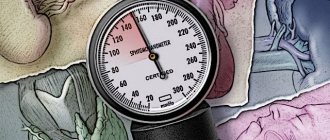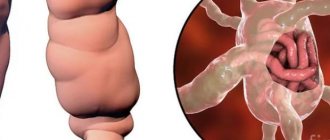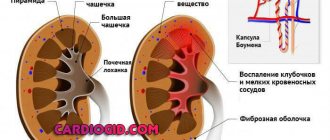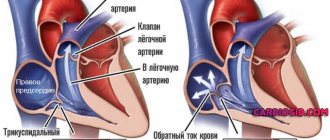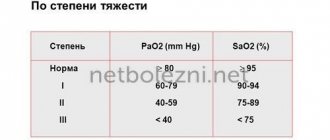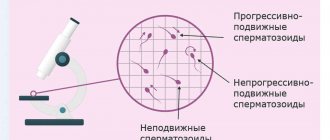Published: 10/15/2021 16:40:00 Updated: 10/15/2021
Hypertension, or arterial hypertension, is a condition characterized by a stable increase in blood pressure, that is, detected through repeated measurements. Accompanying many diseases, it is considered a risk factor for the development of dangerous complications from the cardiovascular system, including stroke and myocardial infarction. Hypertension, as the main cause of the pathology in question, requires taking medications, normalizing the patient’s lifestyle and nutrition.
Blood pressure is the force with which circulating blood acts on the walls of blood vessels. This pressure at the moment of contraction of the heart is called systolic, and during the period of its relaxation - diastolic. The range of normal values for these indicators is quite wide.
In the course of numerous observations [1], scientists came to the conclusion that the risk of cardiovascular complications increases with each additional increase in blood pressure by 10 mmHg. Art. already starting from the level of 115/75 mm Hg. Art. However, drug reduction of pressure only above 140/90 mm turned out to be advisable. Hg Art., therefore, this value is taken as the criterion for determining arterial hypertension.
Causes
In approximately 90% of cases, the cause of a stable increase in blood pressure is hypertension. This diagnosis is made to the patient when no other diseases accompanied by hypertension are found during the examination. Among the latest:
- kidney pathologies – pyelonephritis, glomerulonephritis, polycystic disease, diabetic nephropathy, renal artery stenosis;
- endocrine disorders - neoplasms of the adrenal glands, pancreas or pituitary gland, hyperfunction of the thyroid gland, Cushing's disease or syndrome, pheochromocytoma;
- obstructive sleep apnea syndrome;
- valve defects or atherosclerotic lesions of the aorta.
Regular use of some medications can also cause high blood pressure.
These include oral contraceptives, non-steroidal anti-inflammatory drugs, amphetamines, corticosteroids, drugs containing erythropoietin, cyclosporine, cocaine. The likelihood of developing cardiovascular diseases, including hypertension, is closely related to the following risk factors:
- unhealthy diet, including excess amounts of table salt, saturated fats and trans fats, lack of leafy greens, vegetables and fruits in the diet;
- obesity;
- pathologies of the heart and blood vessels in close relatives;
- age over 65 years;
- sedentary lifestyle;
- chronic stress;
- bad habits – smoking, excessive alcohol consumption.
Prevention
Hypertension is easier to prevent than to treat. To do this, you should adhere to a number of rules that are mandatory for people who are at risk for developing diseases of the cardiovascular system.
- Stop smoking. A bad habit narrows blood vessels, making them fragile and inelastic. Of course, one cigarette a day is not enough to develop hypertension. But if you smoke 10 or more cigarettes a day, the blood vessels are in a state of constant spasm and simply cannot function normally.
- Limit your alcohol intake. The permissible dose of strong drink per day for men is 20 ml, for women - 30 ml.
- Include regular physical activity in your daily routine.
- Walk outdoors more often. This will allow you to fully supply the body with oxygen, which is necessary for the functioning of the heart and blood vessels.
- Salt is a real poison for potential and actual hypertensive patients. The daily norm is only 6 g, which doctors do not recommend exceeding.
- It is important to get rid of excess weight, which creates additional stress on the heart and other internal organs. There is no point in losing kilos suddenly. Optimal weight loss should not exceed 10% of the initial weight.
- Enrich your diet with foods containing potassium, calcium and magnesium necessary for vascular and heart health. These are: egg yolks, dried fruits, low-fat cottage cheese, beans, parsley. This diet will reduce the likelihood of pressure surges.
- The number of animal fats per day should not exceed 60 g, which will prevent the formation of atherosclerotic plaques and blood clots.
- Minimize the amount of stress, try to go to bed and wake up at the same time, getting at least 8 hours of sleep a day.
Advice! Visit your doctor regularly to promptly identify arterial hypertension, diseases of the heart, blood vessels, nervous system, and endocrine system.
Treatment of hypertension is a long process. After its completion, you must adhere to recommendations regarding nutrition, daily routine, and physical activity. The sooner you begin to eliminate the disorder, the more effective the therapy will be, and the lower the likelihood of complications of the disease.
Classification
If it is possible to identify a disease that leads to an increase in blood pressure, arterial hypertension is called secondary or symptomatic.
When the cause is unknown, hypertension is considered to be primary hypertension. The latter has a staged course:
- Stage I. There are no obvious signs of disruption of the target organs affected by a stable increase in blood pressure - the heart, kidneys, arterial and venous vessels.
- Stage II. One of the listed signs or a combination of them is present, such as an enlargement of the left ventricle of the heart, a marked decrease in the filtration rate in the kidneys, albumin in the urine, an increase in the thickness of the walls of the carotid arteries or the appearance of atherosclerotic plaques in their lumen. In this case, clinical manifestations of the disease may be absent.
- Stage III hypertension. There is one or more pathologies associated with atherosclerotic processes in the heart and blood vessels - myocardial infarction, acute cerebrovascular accident, angina pectoris, atherosclerosis of the arteries of the lower extremities, or serious kidney damage, manifested by a pronounced decrease in filtration and/or significant loss of protein in the urine.
Arterial hypertension is divided into several degrees depending on the maximum measured blood pressure:
- First degree. Systolic blood pressure is from 140 to 159 mm. Hg Art. and/or diastolic – from 90 to 99 mm. Hg Art.
- Second degree. Systolic blood pressure from 160 to 179 mm. Hg Art. and/or diastolic – from 100 to 109 mm. Hg Art.
- Third degree. Systolic blood pressure is more than 180 mm. Hg Art. and/or diastolic over 110 mm. Hg Art.
There is also an isolated form of arterial hypertension, in which only the systolic pressure numbers are increased while the diastolic pressure is normal.
Types of hypertension
The main sign by which arterial hypertension is diagnosed is an increase in blood pressure above normal levels. The disease can be either persistent or borderline in nature. In the second case, the pressure can be normalized without the use of medications; there are no complications in the form of disturbances in the functioning of the heart, brain, kidneys, or eyes. Doctors divide borderline hypertension into several clinical types. This:
- menopausal (occurs in women during menopause);
- sports (the disorder is encountered by athletes who regularly experience intense physical activity);
- professional (associated with noise, vibration and other factors, by eliminating which you can get rid of pressure surges);
- psychoneurological (problems with well-being are associated with nervous overstrain and stress);
- youthful (associated with active growth, during which internal organs and systems become weakened).
The alcoholic form of hypertension is also common (occurs due to the consumption of alcoholic beverages)
The above forms of the disease do not pose a serious health hazard. The condition is corrected by eliminating the factors that cause increased pressure. For example, sedatives are prescribed if hypertension is of a neuropsychiatric nature, hormone therapy is prescribed for menopause, and a decrease in physical activity is prescribed for a sports type of disorder.
In some cases, borderline hypertension becomes persistent. In this case, blood pressure is almost constantly increased, internal organs and systems experience increased stress, which affects their work. Most often, people who are part of a unique risk group face a persistent form of the disease (hypertension of degrees 2 and 3).
Symptoms
Often, an increase in blood pressure is not accompanied by a deterioration in health and may go unnoticed by the patient, which is why it is so important to regularly measure blood pressure, especially for middle-aged and elderly people.
Manifestations of hypertension may include the following symptoms:
- headache, mainly in the morning after waking up;
- nosebleeds;
- hemorrhage under the mucous membrane of the eye;
- heart rhythm disturbance;
- blurred vision, flickering spots;
- tinnitus.
A sharp jump in blood pressure to high numbers, accompanied by a pronounced deterioration in well-being, is called a hypertensive crisis. Most often it occurs when systolic pressure rises to more than 180 mm Hg. Art. and/or diastolic over 120 mm Hg. Art. In this case, the patient experiences weakness, nausea, vomiting that does not bring relief, impaired consciousness, anxiety and fear, muscle tremors, and chest pain.
How does hypertension begin?
You can suspect that the vessels have stopped fully allowing constant flows of blood to pass through a number of symptoms, including not only tonometer readings, but also:
- cardiopalmus;
- headaches, often worsening after exercise;
- dizziness, which sometimes ends in fainting;
- stabbing or aching pain in the heart area, radiating to the left arm or shoulder blade;
- the appearance of tinnitus and black spots before the eyes;
- insomnia.
This picture is similar to the manifestations of heart failure. And often it is hypertension that causes the development of problems with the functioning of the heart.
Important! Hypertension of the 1st degree only sometimes manifests itself. Signs appear occasionally; the patient attributes them to fatigue or stress, postponing a visit to the doctor. This leads to the fact that the first degree passes into the second, and then into the third. The more severe the stage of the disease, the more often your health worsens. A person loses his ability to work and becomes disabled.
Diagnostics
The main sign of hypertension is a stable increase in blood pressure, detected in at least three measurements on different days in a calm environment. When measuring blood pressure for the first time in a hospital or clinic, to ensure the correctness of the results obtained, it is important to follow the following rules:
- Before the examination, the patient needs to sit for a few minutes in a quiet room to calm down;
- the size of the tonometer cuff must correspond to the thickness of the arm, and the device itself must be mounted at the level of the heart;
- two measurements are performed with an interval of 1-2 minutes on each hand; if there is a large difference in the obtained figures, an additional measurement is taken;
- in elderly patients, as well as people suffering from diabetes mellitus, or if a decrease in blood pressure is suspected in case of a change in body position, measurements are taken in the first and fifth minutes in a standing position;
- Additionally, heart rate is measured for 30 seconds.
The doctor, in a conversation with the patient, clarifies at what age the pressure first began to increase, whether there are any symptoms such as snoring with pauses in breathing during sleep, attacks of muscle weakness or sudden heartbeat with sweating and headache, and unusual impurities in the urine.
It is also important to find out what medications and dietary supplements he is taking. As part of the first stage of examination for hypertension, the following tests are performed:
- clinical blood test;
- general urine analysis, detection of microalbumin in its single and daily portions;
- biochemical blood test (cholesterol, lipoprotein levels to assess the risk of atherosclerosis, blood electrolytes - potassium, sodium, chlorine, calcium, as well as glucose and creatinine);
- determination of the level of glycated hemoglobin;
- determination of the concentration of hormones - thyroxine, triiodothyronine and thyroid-stimulating hormone, antibodies to thyroid peroxidase and thyroglobulin, aldosterone.
If a hereditary predisposition to the disease is suspected, it is possible to determine polymorphisms of genes associated with the development of arterial hypertension.
In order to clarify risk factors for the development and identify existing cardiovascular pathologies in hypertension, instrumental diagnostic methods are used:
- 24-hour blood pressure monitoring;
- electrocardiographic study;
- echocardiography;
- 24-hour Holter monitoring;
- duplex scanning of the brachiocephalic, renal or iliofemoral arteries;
- ultrasound examination of the kidneys and adrenal glands;
- fundus examination.
For hypertension, it is important to monitor blood pressure at home by keeping a diary, in which it is necessary to record all the results of measurements over time, medications taken and episodes of stress that can provoke a rise in blood pressure. In this case, measurements must be taken in a sitting position, after several minutes of rest, keeping your hand at the same level as your heart.
Treatment
With a moderate and low risk of cardiovascular complications, the patient is recommended only to change his or her lifestyle, adjust the diet, lose weight, increase physical activity and special exercises for hypertension, and give up bad habits while regularly measuring blood pressure.
Often these measures are enough to normalize blood pressure. A diet for hypertension involves limiting table salt, caffeine, hot, salty, smoked and spicy foods, high-fat foods, offal, confectionery with butter cream and alcoholic beverages. It is permissible to consume no more than 5 g of salt per day outside of an exacerbation of the disease. The recommended daily fluid intake is 1-1.2 liters.
In case of unsuccessful non-drug treatment for several months, as well as in case of a high risk of complications, they resort to antihypertensive therapy using medications for hypertension, the goal of which is to reduce blood pressure to less than 140/90 mm. Hg Art. For patients with diabetes or people already suffering from pathologies of the cardiovascular system, the target pressure level is even lower - 130/80 mm. Hg Art.
Modern drug treatment of hypertension includes a combination of two or more drugs from the following groups:
- calcium antagonists;
- angiotensin-converting enzyme inhibitors;
- angiotensin II blockers;
- diuretics (diuretics);
- b-blockers;
- alpha-blockers.
The vast majority of them are available in the form of tablets for hypertension.
